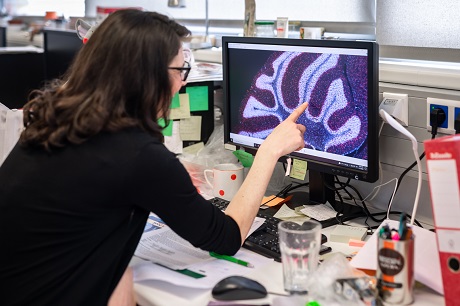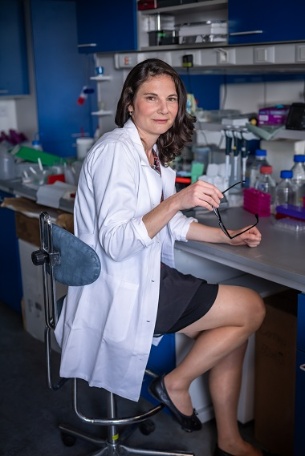
Our research must benefit patients, says researcher advancing cancer treatment
23. 06. 2022
Hana Hanzlíková from the Institute of Molecular Genetics of the CAS is paving the way for new cancer treatment. With her international team, the researcher discovered which sites in the DNA molecule inside tumour cells represent the basis of the effect of anticancer drugs (so-called PARP inhibitors). These are used to treat certain types of cancer, such as breast and prostate cancer. Thanks to new research findings, it is possible PARP inhibitors may soon be used to treat other types of cancer as well.
Your discovery has great potential and is likely to have a significant impact on the advancement of cancer treatment. Are you excited?
Yes, very! It’s one of the biggest discoveries I’ve made so far. It completely changes the concept of cancer treatment and how it’s viewed, and I am convinced that it will have a positive impact. With basic research, it usually takes a long time for other researchers to respond to new findings, but this is different. We published the first research on how PARP inhibitors work in 2018 and since then, our work has already garnered a great response, especially from people directly involved in cancer treatment and pharmaceutical companies.
Getting from basic research to a cure is usually a long and winding road. Which stage are you at now?
We’re currently focused mainly on connecting with experts who can test our findings using mouse models. We are communicating with the AstraZeneca pharmaceutical company, which is probably the biggest seller of PARP inhibitors at the moment. The issue is that it usually takes up to ten years for a new drug to go through all clinical trials and get certified. But our advantage is that the drugs already exist, and we “only” design them better or tailor them to specific patients’ needs. So I hope we’ll be able to avoid lengthy clinical trials.
PARP inhibitors that kill certain cancer cells have been on the market for almost a decade now. However, you were the first to manage to describe why and how they work. How did researchers view these anticancer drugs prior to your discovery?
The enzymes in damaged DNA are “captured” by PARP inhibitors, and until our discovery, it was a mystery where exactly within the cell this happens. Experts assumed that it worked on the principle – figuratively speaking – of a policeman keeping an eye out for damage, and that it only applied to damaged cells. However, we found that this role is played by a protein that is also involved in the division of undamaged cells and is responsible for joining and repairing sections of DNA. We were able to describe an entirely new repair enzyme and molecular pathway.
Chance sometimes plays a role in important discoveries. Was it so in this case?
It wasn’t entirely a chance discovery. But we weren’t originally interested in cancer cells; we had been studying normal cells and damage caused to them, for instance, by UV radiation, radiation, or chemicals. It turned out that at a certain stage of cell division, when the DNA is being duplicated, the cells get more damaged. This surprised us, as we thought they became damaged similarly at all stages of cell division. I began to observe this and do research, studying literary sources and putting together all the existing knowledge and findings. And then it all fell into place and suddenly made sense. In the end, it didn’t even seem like such a big discovery at all. No one before me had pieced it together and looked at it in a similar way.
You’ve been researching DNA damage for 15 years now. What inspires you to look at things from a different angle and go after a new hypothesis?
There are different types of scientists. Some sit and think and come up with something while at their desk. All the big discoveries I’ve made so far in my career have mostly occurred when I would make observations during lab experiments and then develop them further, which I find very exciting. The beautiful thing about science is that you never know what you’re going to stumble across and discover when you look inside cells. And sometimes, you find something special. Some people ignore or overlook it and some don’t. In the latter case, the important thing is to stand up for your opinion and not be afraid. For example, at a previous workplace of mine in England, I had a “fight” with my former boss because I had digressed a bit and overcomplicated the research.
But it had been worth it...
Yes, but it wasn’t easy. However, it’s what allowed us to figure out how PARP inhibitors work and to move on to the current discovery.

Hana Hanzlíková has also researched DNA damage in England, Denmark, and Switzerland.
Is there a lot of competition in your field?
Yes, more and more researchers are interested in cancer research and new technologies are advancing it rapidly. I welcome competition and it in fact motivates me in my own research. When there is competition, you know you are working on something important, which drives you on.
About 200 types of cancer exist, some of which can now be successfully treated. But there are still resistant strains and many cancers we don’t know how to deal with. Do you believe that one day we will manage to beat cancer as a whole?
Cancer treatment keeps getting better and better. It wasn’t that long ago when people were dying of cancer in their fifties, but now treatment can help extend their lifespan. We’re saving a lot of lives; breast cancer, for example, can be treated very effectively thanks to PARP inhibitors. If you know the genetic background, which proteins to target, and how the molecular pathways work, then you can use targeted cancer drugs to treat patients. But I don’t believe we’re going to be able to treat all types of cancer.
In addition to cancer, your research also examines neurodegenerative diseases. What does it focus on specifically?
Unlike cancer, during which cells divide uncontrollably and form a tumour, DNA damage in neurodegenerative diseases leads to cell death. Therefore, the repair mechanisms that the cell uses during cell division cannot be used in this case. So we are trying to detect new factors of the DNA repair pathways. We’ve been studying rare neurodegenerative diseases until now, but in the future, we would like to apply our findings to treating common diseases such as Alzheimer’s disease. We have patients all over the world – there aren’t many of them, usually a person is not born with such DNA damage at all, the fetus dying during development. We obtain blood cell samples from them, or sometimes skin biopsies, which we then use to look for new treatments, to try to design medication.
Is it possible to help the patients you work with?
Individually, we can help in the case of prenatal diagnoses, during which we work with doctors and focus on genes that are not yet described in the database. Should the child be born with a pathogenic mutation, the mother may choose to have an abortion. In terms of being of help, it’s otherwise rather hopeless.
A woman from Slovakia recently contacted me – she had read about us in some scientific article and has a daughter with a mutation in the gene we are studying. But we aren’t capable of helping her daughter yet. We obtained the cells from her, we are studying them, we can suggest a treatment, but it hasn’t been tested out yet. Even though you feel very emotional in these types of situations, I tell myself that we are researching something very rare, it makes sense, it will take us somewhere, and maybe one day, we will be able to find a cure.
Research-wise, what would you like to achieve?
I’d like to continue doing good research and publishing in high-impact journals, but I know that’s not enough. Scientific research must benefit patients. We need to connect with people involved in clinical research and pharmaceutical companies who are able to take new findings and get it to patients.

Mgr. Hana Hanzlíková, Ph.D.
Institute of Molecular Genetics of the CAS (IMG)
Head of the Laboratory of Genome Dynamics of IMG, Hana Hanzlíková’s research focus is on DNA damage in cancer cells and neurodegenerative diseases. She studied biology at the Faculty of Science, Charles University in Prague and molecular and cell biology at the University of Bern, Switzerland. She has worked in England, Denmark, and Switzerland.
Prepared by: Zuzana Šprinclová, Division of External Relations, CAO of the CAS
Photo: Jana Plavec, Division of External Relations, CAO of the CAS
 The text and photographs are released for use under the Creative Commons licence.
The text and photographs are released for use under the Creative Commons licence.
Read also
- Public Hearing: “Making Sense of Open Science”
- SUNER-C concludes after three years dedicated to the renewable energy future
- A trapped state: The pandemic impact on public attitudes, trust, and behavior
- Aerial archaeology: Tracing the footsteps of our ancestors from the sky
- Archaeologists uncover ancient finds along Prague Ring Road
- Our microbiome largely depends on what we eat, says microbiologist Michal Kraus
- The ABCs of writing: Why did its invention mark a turning point for humankind?
- We learn, remember, forget… What can memory actually do? And can we outsmart it?
- New Center for Electron Microscopy in Brno opens its doors to global science
- The hidden lives of waste: What can we learn from waste workers and pickers?
The Czech Academy of Sciences (the CAS)
The mission of the CAS
The primary mission of the CAS is to conduct research in a broad spectrum of natural, technical and social sciences as well as humanities. This research aims to advance progress of scientific knowledge at the international level, considering, however, the specific needs of the Czech society and the national culture.
President of the CAS
Prof. Eva Zažímalová has started her second term of office in May 2021. She is a respected scientist, and a Professor of Plant Anatomy and Physiology.
She is also a part of GCSA of the EU.